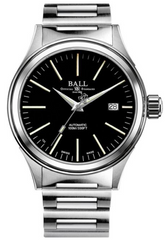Why do we say "He's on the Ball"?
Tuesday - 05 March 2013

Nowadays, if someone has good attention to detail, or notices things that other people miss, we say "he's on the ball".
This sounds like a phrase from the world of sport, but in reality, it was coined because of an American watchmaker.
The story, however, doesn't begin with watches, but with a tragedy.
Nine Dead in Railroad Collision
Ohio, USA. April 18, 1891.
On the railroad, the Toledo Express - a passenger train headed west - is running late.
Meanwhile, on the same track, fast mail train No. 14 is headed east - the opposite direction - and is pounding across the tracks at full steam.
With only one track for trains in both directions, having trains headed for each other is a regular occurrence. The signalmen know what to do.
Railroad controllers order the Toledo Express to take the next siding at Oberlin to allow the fast mail train to pass. There is plenty of time to spare, though stopping in a siding means the Toledo will be knocked further behind schedule.
The Toledo Express reaches the siding at Oberlin. The Toledo's engineer checks his pocket watch. It seems pointless to wait here and get further behind schedule when, with the time available, he could reach Kipton, the next station, and take the siding there.
The engineer decides to continue on to Kipton.
Moments before he reaches the Kipton siding, the engineer spots a train coming in the opposite direction, straight at him, travelling at full speed. It's the fast mail train, No. 14.
Heart thumping, the engineer hits the brakes.
But he knows it's too late.
It is too late.
Nine people die in the crash, including the engineers of both trains.
The local newspaper, the Sandusky Daily Register called it "an Awful Accident".
Getting Railroad Time On the Ball
An investigation by the railway company discovered the cause of the crash. What they discovered was painfully simple. When the engineer checked his watch at Oberlin, it was running three minutes slow.
Wanting to prevent future crashes because of failed watches, they turned to the local master of timekeeping, watchmaker Webb C. Ball.
Ball had already made a name for himself when, in 1883, the year the USA adopted Standard Time, he became the first watchmaker to set his watches using time signals from the United States Naval Observatory.
Following the Kipton crash, the railway company asked Ball to set up a new time-keeping programme for the railroads. This included his watch company manufacturing sturdy, reliable time pieces for use on trains.
In addition, Ball's watch company became the first to manufacture wristwatches approved for use on the railroads.
By the time he retired, Ball was responsible for timekeeping on over 125,000 miles of rail tracks across the USA, Mexico and Canada.
His legendary attention to detail led to the phrase "he's on the Ball".
Ball watches continue to celebrate the company's railroad legacy, and with a Ball watch on their wrist, anyone can stay on the ball.









